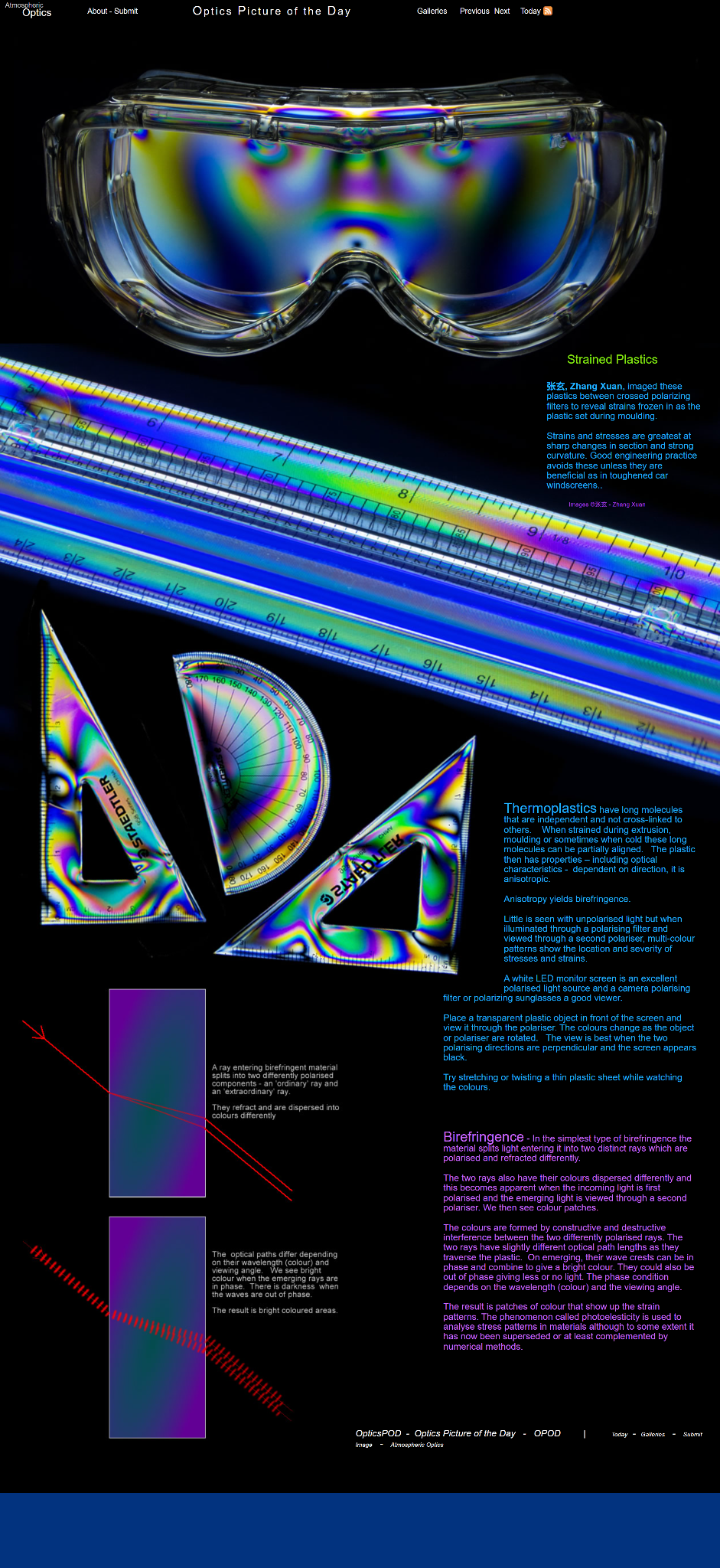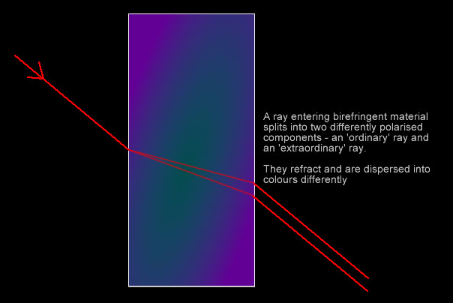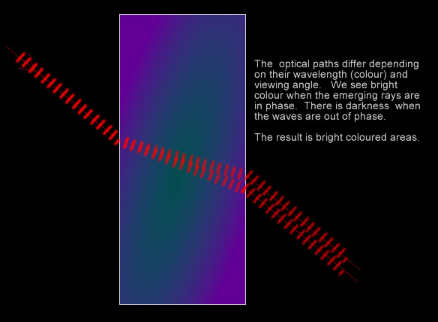OPOD - Strain colours
OPOD - Strain Colours: Revealing the Hidden Patterns in Strained Plastics
When it comes to examining strained plastics, the technique of revealing the frozen strains using crossed polarizing filters can provide valuable insights. These strains and stresses often occur at areas of sharp changes in section and strong curvature. While it is generally good engineering practice to avoid such areas, they can be beneficial in toughened car windscreens. Through the lens of photographer Zhang Xuan, we can witness the intricate patterns of strains in these plastics.
Thermoplastics, characterized by their long, independent molecules that are not cross-linked to others, exhibit interesting properties when subjected to strain during extrusion, molding, or even when cooled. The alignment of these long molecules leads to anisotropy, where the plastic's optical characteristics become dependent on direction. This anisotropy gives rise to birefringence, which is the phenomenon responsible for the colorful patterns we observe.
At first glance, little can be seen with unpolarized light. However, when illuminated through a polarizing filter and viewed through a second polarizer, multi-color patterns emerge, indicating the location and severity of stresses and strains. To perform this observation, a white LED monitor screen serves as an excellent polarized light source, while a camera polarizing filter or polarizing sunglasses can be used as a viewer.
To witness the dynamic display of colors, simply place a transparent plastic object in front of the screen and view it through the polarizer. As the object or polarizer is rotated, the colors change, offering a captivating visual representation of the underlying strains. The optimal viewing experience occurs when the two polarizing directions are perpendicular, resulting in a black appearance of the screen.
By stretching or twisting a thin plastic sheet while observing the colors, one can gain a deeper understanding of how strains affect the optical properties of materials. This manipulation allows for a real-time exploration of the relationship between strain and the resulting color patterns.
To comprehend the science behind these captivating colors, it is essential to understand the concept of birefringence. When a ray enters a birefringent material, it splits into two differently polarized components: an "ordinary" ray and an "extraordinary" ray. These rays refract and disperse colors differently, leading to the striking patterns we observe.
The optical paths taken by these rays differ depending on their wavelength (color) and viewing angle. Bright colors appear when the emerging rays are in phase, while darkness occurs when the waves are out of phase. Consequently, the result is an array of bright colored areas that highlight the strain patterns within the plastic.
In its simplest form, birefringence involves splitting light entering a material into two distinct rays that are polarized and refracted differently. These rays also exhibit varying color dispersion, which becomes evident when the incoming light is polarized and the emerging light is viewed through a second polarizer. This observation allows us to witness colorful patches that form as a result of constructive and destructive interference between the two differently polarized rays.
The color patches arise due to the slightly different optical path lengths traversed by the two rays within the plastic. Upon emergence, their wave crests may either be in phase, resulting in a bright color, or out of phase, leading to less or no light being observed. The specific phase condition depends on the wavelength (color) and viewing angle, giving rise to the intricate patterns we see.
The phenomenon of photoelasticity has long been employed to analyze stress patterns in materials. However, it has been partly supplanted or at least complemented by numerical methods in recent times. Nevertheless, photoelasticity remains a valuable tool for visualizing and understanding strain patterns in materials.
In conclusion, the technique of revealing strain colors in plastics through crossed polarizing filters offers a captivating glimpse into the hidden world of strains and stresses. By employing polarized light sources and viewing through polarizers, we can unlock the intricate patterns and gain insights into the behavior of materials under strain. The resulting colorful displays not only showcase the beauty of science but also serve as a valuable tool for engineers and researchers in various fields.

Strained Plastics
张玄, Zhang Xuan, imaged these plastics between crossed polarizing filters to reveal strains frozen in as the plastic set during moulding.
Strains and stresses are greatest at sharp changes in section and strong curvature. Good engineering practice avoids these unless they are beneficial as in toughened car windscreens..
Images ©张玄 - Zhang Xuan
Thermoplastics have long molecules that are independent and not cross-linked to others. When strained during extrusion, moulding or sometimes when cold these long molecules can be partially aligned. The plastic then has properties – including optical characteristics - dependent on direction, it is anisotropic.
Anisotropy yields birefringence.
Little is seen with unpolarised light but when illuminated through a polarising filter and viewed through a second polariser, multi-colour patterns show the location and severity of stresses and strains.
A white LED monitor screen is an excellent polarised light source and a camera polarising filter or polarizing sunglasses a good viewer.
Place a transparent plastic object in front of the screen and view it through the polariser. The colours change as the object or polariser are rotated. The view is best when the two polarising directions are perpendicular and the screen appears black.
Try stretching or twisting a thin plastic sheet while watching the colours.

A ray entering birefringent material splits into two differently polarised components - an 'ordinary' ray and an 'extraordinary' ray.
They refract and are dispersed into colours differently

The optical paths differ depending on their wavelength (colour) and viewing angle. We see bright colour when the emerging rays are in phase. There is darkness when the waves are out of phase.
The result is bright coloured areas.
Birefringence - In the simplest type of birefringence the material splits light entering it into two distinct rays which are polarised and refracted differently.
The two rays also have their colours dispersed differently and this becomes apparent when the incoming light is first polarised and the emerging light is viewed through a second polariser. We then see colour patches.
The colours are formed by constructive and destructive interference between the two differently polarised rays. The two rays have slightly different optical path lengths as they traverse the plastic. On emerging, their wave crests can be in phase and combine to give a bright colour. They could also be out of phase giving less or no light. The phase condition depends on the wavelength (colour) and the viewing angle.
The result is patches of colour that show up the strain patterns. The phenomenon called photoelesticity is used to analyse stress patterns in materials although to some extent it has now been superseded or at least complemented by numerical methods.
Note: this article has been automatically converted from the old site and may not appear as intended. You can find the original article here.
Reference Atmospheric Optics
If you use any of the definitions, information, or data presented on Atmospheric Optics, please copy the link or reference below to properly credit us as the reference source. Thank you!
-
<a href="https://atoptics.co.uk/blog/opod-strain-colours/">OPOD - Strain colours</a>
-
"OPOD - Strain colours". Atmospheric Optics. Accessed on November 26, 2024. https://atoptics.co.uk/blog/opod-strain-colours/.
-
"OPOD - Strain colours". Atmospheric Optics, https://atoptics.co.uk/blog/opod-strain-colours/. Accessed 26 November, 2024
-
OPOD - Strain colours. Atmospheric Optics. Retrieved from https://atoptics.co.uk/blog/opod-strain-colours/.